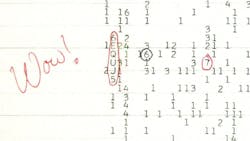SETI Celebrates 30 Years of Searching for Extraterrestrial Signals
What you'll learn:
- SETI methodology and facilities.
- Fractal messaging and OSETI.
- Origins of alien signal searching.
- SETI accomplishments despite no ET signals.
- BOINC-based citizen science project.
- Looking ahead at SETI programs and initiatives.
People have been looking up at the Milky Way for thousands of years, marveling at its vastness. It was only a matter of time before they began to wonder if life similar to ours could exist on the billions of other worlds that inhabit not only our galaxy but the entire observable universe. In 1961, astrophysicist Frank Drake formulated an equation on the probability of life on other worlds—not to evaluate the number of civilizations, but as a way to spark scientific dialogue, which was presented at the first scientific meeting on the search for extraterrestrial intelligence (SETI).
SETI is a global scientific effort focused on discovering signs of intelligent life outside Earth through projects like Breakthrough Listen. It uses specialized equipment, including radio telescopes, that point toward the sky to detect and analyze narrow-bandwidth radio waves or electromagnetic radiation patterns. These could indicate signs of technological activity (radio transmissions or optical signals) produced by alien civilizations.
SETI Methodology and Facilities
SETI relies on plenty of methods and technologies to seek out signals in the universe. For starters, it deploys large radio telescopes with high sensitivity to detect exactly where the narrow-bandwidth signals emit. Facilities used for SETI research include the Green Bank Telescope in West Virginia, the Australian-based Parkes Observatory, and the Allen Telescope Array (Fig. 1) in California.
The Allen Telescope Array (ATA), located at the Hat Creek Radio Observatory in Northern California, has 42 dishes (each 6.1 meters wide). These are designed for continuous SETI searches operating with a frequency range of 1 to 11 GHz across multiple octaves of the radio spectrum. Some equipment underwent upgrades, expanding the frequency to 15 GHz for specific research projects. With its wide field of view (2.45 degrees at a 21-cm wavelength), the ATA can observe multiple star systems simultaneously.
Astronomers point the telescopes at specific stars or sky regions to collect microwave spectrum raw data before digitizing and transmitting them to supercomputers that look for particular signals. The researchers aim to detect these signals that differ from the naturally produced ones. Digital-signal-processing algorithms split the data based on time and frequency for analysis, finding unique variations compared to the background noise.
Filters then exclude human-made radio-frequency interference and distinguish narrowband signals measuring a few hertz—produced by artificial transmitters. Prospective alien transmission signals are identified via thresholding and pattern recognition techniques. While thresholding sets a boundary to identify signal and noise, pattern recognition analyzes those characteristics to find properties matching predefined patterns, like those expected from alien transmission signals.
Additional analysis is performed if they find prospective signals to exclude false positives. Astronomers may also rely on multi-antenna observations to determine if the signal originates from a true point source or radio interference. Further observations can help verify potential signals. If the telescopes constantly detect signals from the same area in the sky, the chances of it being artificial increase.
>>Check out this Series Library for more key moments in electronics history
Fractal Messaging and OSETI
SETI has recently started using fractal messaging and advanced signal reconstruction for technosignature detections. Fractal messaging deploys self-similarity and scale variance characteristics for encoding and sending messages that can be decoded across multiple time and space scales. Advanced signal reconstruction involves decoding unknown-origin signals regardless of the encoding method.
Another technique they use is Optical SETI (OSETI) to detect visible and infrared laser signals (pulsed laser or continuous wave) that alien civilizations might transmit. OSETI deploys optical telescopes equipped with photomultipliers to analyze light for unique patterns or pulses, potentially indicating artificial origins. Beam splitters and fast detectors capture the time and intensity profile of pulses to distinguish them from natural astrophysical phenomena. Through projects such as PANOSETI, telescope arrays scan the sky to search for transient optical signals like millisecond singleton laser pulses that could come from extraterrestrials.
Origins of Alien Signal Searching
The modern search for alien signals can trace its origins back to 1959 when physicists Philip Morrison and Giuseppe Cocconi proposed that radio telescopes could detect interstellar communications. Their idea sparked early SETI initiatives, including Frank Drake’s 1960 Project Ozma, which targeted the stars Tau Ceti and Epsilon Eridani using the Green Bank radio telescope.
That project helped lay the foundation for SETI’s first scientific conference, where discussions like Drake’s now-famous equation (Fig. 2) kicked off a new era of organized, data-based efforts to detect signals from intelligent life in the universe.
During the late 1960s and following decades, NASA started low-level SETI research, assisting with various projects like the Microwave Observing Project, High-Resolution Microwave Survey, and Project Orion. In 1971, researchers authored the Cyclops Report, proposing the construction of a 1,500-dish array to find alien signals. However, this was canceled as it cost too much—$10 billion.
In 1981, NASA and the Society funded Suitcase SETI, a portable high-resolution spectrum analyzer that integrates on large radio telescopes to assist with SETI research. Once it completed field tests throughout 1982, Suitcase SETI was deployed in 1983 with the 26-meter Harvard/Smithsonian radio telescope at Oak Ridge Observatory. This system is well-known for analyzing 131,000 narrowband channels.
Thomas Pierson and Jill Tarter established the SETI Institute on November 20, 1984, with a focus on radio searches. Carl Sagan, Frank Drake, and other leaders became involved in it by introducing astrobiology, helping shape the organization's mission.
In 1993, Congress discontinued federal funding for the SETI Institute, which shifted to private donation funds from donors like Microsoft co-founder Paul Allen and Intel co-founder Gordon Moore. This also led to Project Phoenix—formed in February 1995 and ending in March 2004—and optical SETI breakthroughs. Project Phoenix, an extensive SETI effort, surveyed over 800 Sun-like stars approximately 200-240 light years away, focusing on 1,200- to 3,000-MHz narrowband radio signals at 1-Hz resolution.
In January 2016, Yuri Milner formed the Breakthrough Listen Initiative, a $100 million program to accelerate the search for extraterrestrial signals. It's based at UC Berkeley and operates in collaboration with major observatories, including the Green Bank Telescope and Parkes Observatory. Thanks to Breakthrough Listen, SETI observations underwent a significant boost, collecting petabytes of data and surveying billions of radio channels. This project's approach involves scanning a million nearby stars and the centers of a hundred galaxies. It covers a wide frequency range of 1 to 10 GHz for radio astronomy.
SETI Accomplishments Despite No ET Signals
Sadly, SETI hasn't found any extraterrestrial signals in the cosmos. But that doesn't mean it didn't make any significant accomplishments. SETI scientists have improved our understanding of the formation of planets, stars, and the universe.
They used the Atacama Large Millimeter/submillimeter Array (ALMA) to investigate protoplanetary disks and their shaping process to understand how planets form in harsh environments, including ultraviolet radiation. ALMA operates with a frequency ranging from 35 GHz to 950 GHz, covering wavelengths from 8.6 mm to 0.32 mm (Fig. 3).
SETI has also investigated Mars' hydrology and possible habitability by looking into its surface/subsurface processes, such as recurring slope linear (RSL) and brines' role in landslides. The scientists have also conducted studies with Earth's extremophiles in areas like Antarctica's McMurdo Dry Valleys to determine how life may survive in extraterrestrial environments.
Recently, a collaborative effort from SETI, NASA, and the Universities Space Research Association used machine learning to discover 69 new exoplanets. SETI also partnered with Unistellar, involving participants in the verification and observation of exoplanets like TIC 139270665 b, which was discovered by NASA's TESS mission. This demonstrates SETI's contribution toward progressing exoplanet research through public participation.
What About Wow!?
In 1977, Ohio State University's Big Ear radio telescope detected the Wow! Signal (Fig. 4), a potential sign of extraterrestrial life, as it exhibited a narrowband frequency and intensity. For decades, the SETI community has investigated and debated its origins.
More recent studies suggest that the signal came from hydrogen clouds or a comet rather than alien life. Although it's not an alien origin, this accomplishment demonstrates SETI's anomaly detection capability and inspires scientific exploration.
BOINC-Based Citizen Science Project
SETI@home, launched in 1999 by the University of California, Berkley, is a citizen science project that leveraged millions of computers globally for radio signal analysis. It used the Berkeley Open Infrastructure for Network Computing (BOINC) platform. SETI@home remained in operation for 20 years—it involved 5.2 million volunteers from 226 countries, reached up to 617 teraFLOPS of computational power, and made science more accessible.
In addition, SETI@home processed 2.6 × 1023 floating-point operations, using data from the Arecibo radio telescope that produced 35 GB of data a day. This project helped improve signal-analysis techniques, raise public awareness for the search for artificial signals, and inspired computational projects.
So far, SETI has received hundreds of millions of dollars for telescope upgrades, exoplanet research, astrobiology, planetary protection research, education initiatives, and extraterrestrial signal detection. It still collects funds from foundations, private donations, and research grants.
Looking Ahead: SETI Programs and Initiatives
In July 2024, SETI established STRIDE (Fig. 5) and awarded it with a $500,000 fund to support technology development and research initiatives. These focused on projects aiming to improve the search for extraterrestrial signals. Before that, the estate of Qualcomm co-founder Franklin Antonio made a $200 million donation to SETI as a permanent SETI research fund, which supports searching for alien signals using the Allen Telescope Array. NASA granted SETI with a $4.7 million fund in 2020 for planetary protection research. However, government funds aren't reserved for any SETI searches.
Private donors allocate funds for the SETI work, and the institute has an annual budget ranging between $25 million to $30 million. With this distinction, SETI searches can move forward regardless of previous government funding cuts, like the termination of NASA's SETI program in 1993. At the time, Nevada Senator Richard Bryan led the effort to get it shut down, stating millions of dollars were spent without results.
It's worth funding this program, as SETI improves our understanding of life in the universe, presents innovations, and supports education. Grants help progress research for scientific purposes while searching for alien life.
Technological advances, more collaborative efforts, and new techniques in the search for alien life are expected to drive SETI expansion. The project aims to deploy next-gen radio telescopes, including SKA-Low and SKA-Mid, offering higher sensitivity, wider frequency ranges, and surveying more stars and galaxies than other instruments. SKA-Low will operate from 50 to 350 MHz while SKA-Mid operates at 0.35 to 15.4 GHz. Both are expected to use advanced array configurations and backend technologies for scientific reach optimization.
Other developments include COSMIC SETI's integration of SETI capabilities into radio telescopes, such as the very large array (VLA). Researchers can then access an independent copy of VLA's data streams for full-time technosignature searches across a wide frequency range and star systems. This makes VLA one of SETI's most powerful instruments.
Citizen science projects, like the Unistellar Network, continue gaining considerable attention, leading to worldwide participation in new astronomical observations and discoveries.
Although finding aliens somewhere in the universe is extremely exciting, humanity should proceed with caution as they could be hostile. Late physicist Stephen Hawking warned, "If aliens visit us, the outcome would be much as when Columbus landed in America, which didn't turn out well for the Native Americans." Instead, he suggests humans should avoid contact to keep the danger away as we likely wouldn't know if aliens possess advanced technology and weaponry, potentially spelling disaster for humans.
With the sheer number of stars in the universe and potential planets orbiting them, it's not so far-fetched to think intelligent life exists out there, and it might not keep our best interests in mind. Then again… maybe they're good.
>>Check out this Series Library for more key moments in electronics history
About the Author
Cabe Atwell
Technology Editor, Electronic Design
Cabe is a Technology Editor for Electronic Design.
Engineer, Machinist, Maker, Writer. A graduate Electrical Engineer actively plying his expertise in the industry and at his company, Gunhead. When not designing/building, he creates a steady torrent of projects and content in the media world. Many of his projects and articles are online at element14 & SolidSmack, industry-focused work at EETimes & EDN, and offbeat articles at Make Magazine. Currently, you can find him hosting webinars and contributing to Electronic Design and Machine Design.
Cabe is an electrical engineer, design consultant and author with 25 years’ experience. His most recent book is “Essential 555 IC: Design, Configure, and Create Clever Circuits”
Cabe writes the Engineering on Friday blog on Electronic Design.









